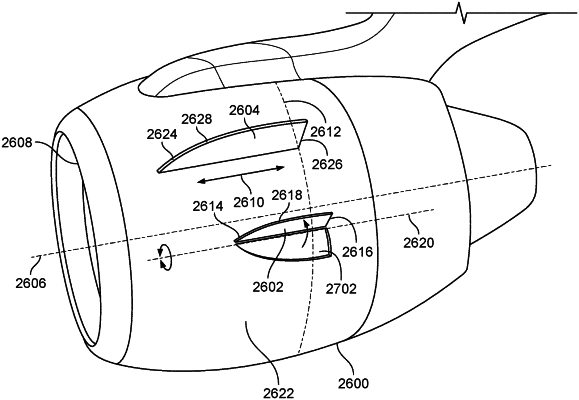| CPC B64C 23/06 (2013.01) [B64D 29/00 (2013.01)] | 12 Claims |

|
1. An apparatus, comprising:
a wing;
a nacelle of an aircraft engine, the nacelle coupled to the wing via a pylon extending downward from the wing, the nacelle including an outer surface defining an outer circumference, the nacelle further including a recess formed in the outer surface;
a first chine oriented in a fore-aft direction and rotatably coupled to the nacelle at a first location about the outer circumference, the first chine rotatable between a stowed position and a deployed position relative to the outer surface about an axis of rotation, the first chine including a leading edge, a trailing edge, and an outer mold line, the outer mold line of the first chine defining a length of the first chine, the outer mold line of the first chine received in the recess when the first chine is in the stowed position, the outer mold line of the first chine extending radially outward from the outer surface when the first chine is in the deployed position; and
a second chine oriented in the fore-aft direction and fixedly coupled to the nacelle at a second location about the outer circumference, the second location circumferentially offset from and positioned above the first location, the second chine including a leading edge, a trailing edge, and an outer mold line, the outer mold line of the second chine defining a length of the second chine, the length of the second chine being greater than the length of the first chine, the leading edge of the first chine being located along the fore-aft direction between the leading edge of the second chine and the trailing edge of the second chine;
wherein, in response to an airflow presented at the first chine and at the second chine, the first chine is configured, based on the length, the orientation, and the location of the first chine relative to the length, the orientation, and the location of the second chine, to:
not generate a vortex when the first chine is in the stowed position; and
generate a first vortex when the first chine is in the deployed position, the first vortex to spoil a second vortex that is otherwise generated by the second chine in the absence of the first vortex.
|